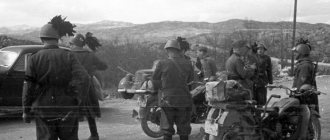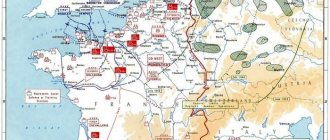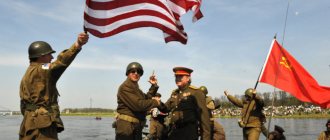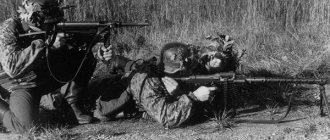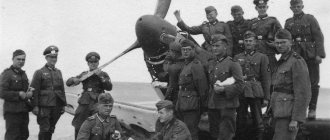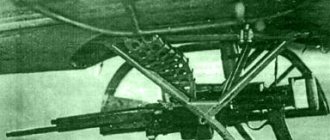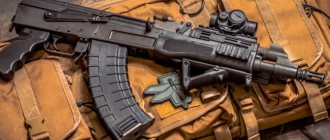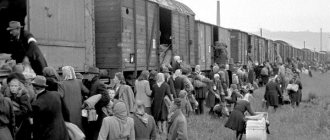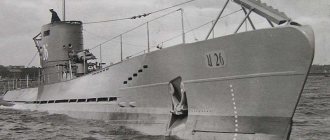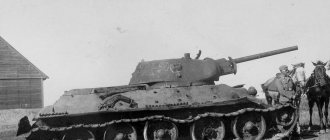The Allied Landings in Sicily (or Operation Sicilian or Operation Husky) was a World War II operation conducted by the Allies against Italo-German forces stationed in Sicily. Lasted from July 9, 1943 to August 17, 1943. The largest amphibious assault in history. It became a prologue to the Italian campaign of 1943-1945. The experience gained by the Allies during the Sicilian operation was applied during the Normandy landings (Operation Overlord) in 1944.
Balance of power
The Allies were represented by American, British and Canadian troops. Also, several countries participating in the anti-Hitler coalition allocated naval and air units. General command was exercised by General D. Eisenhower. General H. Alexander led the ground units assembled into the 15th Army Group. It included the US 7th Army under General J. Patton and the British 8th Army under General B. Montgomery, with the support of the 1st Canadian Infantry Division under General E. McNaughton. Three commando squads and three ranger battalions were also involved. In total there are about 470 thousand people, 5 thousand aircraft, 1.8 thousand guns and 600 tanks.
The 6th Army of the Italian Armed Forces under General A. Guzzoni was based in Sicily. It consisted of the 12th and 16th Coast Guard Corps, four infantry divisions and the 14th Wehrmacht Tank Corps. In total, about 340 thousand people, 600 aircraft, 220 guns and 150 tanks (later another 91 units were transferred).
Successfully performed operation
Before the invasion, British intelligence carried out a cunning operation to mislead the enemy. The plan was carried out so well that the leaders of German intelligence did not have any doubts about the authenticity of the documents transferred to them from Spain, which were found in the clothes of an “English officer” whose corpse was washed up on the Spanish coast by a wave. Among these documents was a letter from the Deputy Chief of the Imperial General Staff of the British Army, Lieutenant General A. Nye, to General H. Alexander. The deceased “officer” apparently had to hand it over to the recipient. The letter referred to recent official cables regarding upcoming operations. The letter's author's comments indicated that the Allies intended to land in Sardinia and Greece, although they were trying to make the German command assume that their goal was Sicily.
Surviving fragments of the defensive fortifications of the airfield in Syracuse
This information coincided with the opinion of A. Hitler, who believed that an Allied landing in Sardinia was more likely, since from this island it was easy to reach Corsica, which could serve as a springboard for an invasion of France or Italy. Therefore, not relying on his Italian allies, A. Hitler ordered the transfer of the 90th Motorized Division to Sardinia, where four Italian divisions were already stationed. In addition, the 11th Airborne Corps (consisting of two parachute divisions) under the command of General Student was transferred to the south of France in order to use airborne troops to launch a counterattack in the event of an Allied landing in Sardinia.
Plan of the Sicilian operation
At the Casablanca Conference of 1943, the Allies determined that they would not be able to open a second front in France. Therefore, it was decided to organize a landing on Sicily. For this it was supposed to use the troops of the North African campaign, which at that time was coming to an end.
The objectives of the operation were:
- the cleansing of Sicily;
- the destruction of the Axis fleet and the organization of free navigation in the Mediterranean Sea;
- preparing a springboard for the invasion of Italy;
- putting pressure on Mussolini and, ideally, bringing Italy out of World War II.
The Allies developed two plans for the operation. According to the first, two armies landed in the west and east of the island, followed by advancement to the center and encirclement of the enemy. In this situation, the forces of the “axis” would be destroyed. This plan had huge risks, since the two allied armies were unable to support each other. The second plan involved landing next to each other and then moving deeper into the island. As a result, the command decided to act according to the second scheme.
The 7th Army was to land at Djela Bay south of the center of the island, namely:
- 1st Infantry Division - in the center of the bay;
- 3rd Infantry and 2nd Armored Divisions - west of Licata;
- 45th Infantry Division - east of Scoglitti;
- 82nd Airborne Division - behind enemy lines at Gela and Scoglitti.
The landing of the 8th Army was envisaged in the southeast of the island:
- 13th Corps - north of Noto Bay near Avola;
- 30th Corps - on both sides of Cape Passero.
Both armies had to close the 40-kilometer gap between them and clear the coast, after which the 8th Army would go north along the eastern bank to Messina, and the 7th would cover the flank of the allied army and the rest of Sicily.
To ensure the success of the landing, several diversionary operations were carried out. During one of them, codenamed “Minced Meat,” the British planted the corpse of an “Englishman” along with a briefcase containing “secret documents” on the shores of Spain. It followed from them that the Allies were planning a landing in Greece. During the second Operation Native Brimstone, the British recruited the German Admiral Canaris. Soon he was “surrendered” to the enemy’s counterintelligence in Bulgaria. Together with Canaris, documents fell into the hands of the Wehrmacht, according to which the Allies hoped to cleanse Sardinia.
As a result, Hitler ordered the withdrawal of ten divisions from Sicily, transferring them to the Eastern Front to participate in the Battle of Kursk. Thus, by the time the Allies arrived, the 15th Motorized Division, the Hermann Goering Division, six coast guard divisions and four reserve divisions, which had previously suffered serious losses in other battles of World War II, were stationed on the island.
"Mosquitoes" Axes are activated
On the night of July 19, in the Strait of Messina, a patrol of “short” MTBs “saw a submarine off Reggio” and attacked it with depth charges. The boats were immediately illuminated by searchlights and fired at by shore batteries at close range. MTB-75 was hit; two crew members died. The stricken boat was towed to Augusta.
On the night of July 21, Italian MS-21, MS-51, MS-53 and MS-66 east of Cape Campolato, north of the entrance to Augusta Harbor, attacked the patrol destroyers Quantoc and Adrias. During the battle, MS-66 was severely damaged, and the commander of the V flotilla of torpedo boats, Captain di Corvetto C. Castagnacci, who was on it, was killed.
Greek escort destroyer Adrias
© warspot.ru
“Khanty” reported “a battle with three torpedo boats” and announced the “sinking of two of them”; They themselves received several hits from the boats' cannons, and two crew members on the Quantock were killed.
On July 16, the 3rd and 7th Schnellbot flotillas were consolidated into the 1st Division, which was headed by the commander of the 3rd Flotilla, frigate captain G.M. Schultz. At this point, the combat-ready S-55, S-30 and S-36 of the 3rd Flotilla and the S-151, S-152, S-154 and S-155 of the 7th were in Salerno; another 10 boats were under repair.
At 13:20 on July 19, Schultz with 6 schnellboats left Salerno and headed for the Strait of Messina. Messina was passed at 21:00, after which the formation made a long detour to the east. At 00:31 on July 20, an enemy convoy was spotted traveling from the south to Syracuse. The convoy's composition was defined as "three transports, two LSTs, three destroyers and a corvette."
The attacks began at 01:12. The sinking of 2 destroyers, a 3,000-ton ship and the destruction of an 8,000-ton transport were reported. Having fired almost all the torpedoes, at 01:40 the schnellbots turned to Crotone, where they arrived at 08:45.
German Schnellboat S-30
© warspot.ru
In fact, the Germans attacked a convoy of two ships and two LSTs en route from Gela to Syracuse, escorted by the American destroyer Niblack and the patrol ship PC-556, as it was about to enter the fairway. After the Americans “opened fire on two torpedo boats, they fled north, hiding behind a curtain of smoke.”
In Crotona there were no torpedoes or fuel for the Germans. Moreover, they didn’t stay here for long. At 01:50 on July 21, the harbor of Crotona was fired upon by the English light cruiser Aurora. The Schnellbots had gone to sea earlier, but there was no talk of attacking the enemy - the S-30 had only one torpedo for 6 boats. The Schnellbots went to Taranto, but here, too, there were no torpedoes or fuel for them.
It was not until 27 July, after fuel and ammunition had arrived, that four schnellboats of the 3rd Flotilla left Crotona to search the area east of Syracuse, but it proved unsuccessful.
American patrol ship PC-556
© warspot.ru
On the evening of July 29, four schnellbots left Crotona after reporting an “enemy formation northeast of Punta Stilo,” but did not find the enemy. The exit of seven schnellboats from Crotona to the Sicilian shores on July 31 was also unsuccessful. Ten miles east of Syracuse, the Germans "encountered enemy destroyers and were pursued for some time." On the morning of August 1, three boats returned to Crotona, and four went to Vibo Valentina, on the Tyrrhenian coast of Calabria.
On the evening of August 2, three schnellboats left Crotona to take part in the Italian mine-laying operation, but it was interrupted. Since the port of Crotona was damaged by another bombardment of British cruisers, the Germans, proceeding past Messina on the morning of August 3, went to Salerno...
To be continued
Fighting
The operation began on the night of July 9-10, 1943. The British landed in the east of Sicily, the Americans in the center, and the Canadians in the south. Due to the storm, many connections were not where planned. Despite this, the British entered Syracuse with virtually no resistance. The Canadians encountered a local underground movement, but reinforcements arrived in time to stop the Italian counterattack.
The Italian Livorno division and the Hermann Goering division were based near the American landing site. Their advance was hampered by the inability of the wide German tanks to cope with the narrow Sicilian streets. Therefore, the battle began only on the morning of July 11. The Wehrmacht managed to push the enemy back at Gela, then moving on to the Comiso airfield. However, the Americans won here, using the cover of their own ships, which destroyed about 14 enemy tanks. Subsequently, the Wehrmacht's tank offensive was slowed down by superior Allied artillery forces. Then the Italo-Germans changed tactics, moving further from the coast and hiding in the hills. Nevertheless, in this counterattack the Axis forces lost about half of their equipment.
On the same day, Patton withdrew reserves to defend the captured beachheads. However, the Allies were not notified of this. As a result, the British Royal Navy shot down American planes carrying troops. 23 vehicles were destroyed, 318 people were injured, and 83 were killed.
Because Allied commander Harold Alexander had not developed a plan of attack after the landings, the army group was forced to advance inland without coordination between units. Despite this, Vizzini and Augusto were captured.
After this, Sicilian resistance in the British sector increased. In this connection, Montgomery persuaded Alexander to increase the interval between the allied armies. This would allow the British to bypass pockets of resistance and participate in the capture of Messina while the Americans covered the British flank. However, this decision led to a strategic miscalculation. The American infantrymen were forced to return to the coast at Gela, which saved the German tank corps from encirclement.
The situation in the air also remained ambiguous. The combined American-British forces managed to shoot down German planes based in Trapani and Catania. However, German bombers were victorious in the battles over the Strait of Messina.
On July 13, 1943, a meeting began at Hitler's headquarters. The Fuhrer understood the gravity of the situation in Sicily, which was aggravated by the reluctance of the Italians to fight. He determined that if the Allies managed to recapture the island, then they would be able to land either in southern Italy or in the Balkans. Thus, an urgent strengthening of the German army was required. It could only be organized through the transfer of forces from the Eastern Front, which jeopardized Operation Citadel.
On July 14, Mussolini also noted the criticality of the situation. By this point, Allied superiority on the water and in the air had become obvious. Nevertheless, in western Sicily, the Italians managed to contain, but not defeat, US forces at Castrofilippo. On July 16, correspondence took place between Roosevelt and Churchill. Leaders noted that the operation was proceeding faster than planned. On July 19, Hitler openly accused Mussolini of not wanting to wage war. On July 26, the Italian leader was arrested. The new government was headed by P. Badoglio. It was officially stated that Italy was faithful to its allied obligations, but secretly from Berlin it began negotiations with the USA and Great Britain.
While high-level negotiations were ongoing, Patton began planning the capture of the capital of Sicily, the city of Palermo. During the reconnaissance, Agrigento was taken. On July 22, 1943, the capital of the island also fell. The capture of Palermo meant that Sicily was lost to the Axis countries. Therefore, the Italian-German command began to evacuate troops through Messina to mainland Italy. To cover the retreat, an entire defense system was organized, called the “Etna Line.”
The capture of Palermo freed American troops to provide support to the British, who were bogged down in fighting south of Messina. By this point, it became clear that von Kluge would not be able to transfer several divisions from the Eastern Front to Italy, otherwise this would lead to the complete failure of Operation Citadel. Italy itself also refused to participate in the battles south of Sicily. Thus, only German submarines and torpedo boats offered resistance to the Allies. On August 8, two Italian light cruisers shelled American troops in the north of the island. However, upon reaching the heights of Ustica, the battle was stopped. Thus, Rome finally took a neutral position.
By 10 August the British were again mired in fighting, this time in the Catania area. To support them, planning began for additional landings. At this time, the Americans were advancing on Troina. Despite the Allied successes, the Axis troops managed to evacuate the island: on the night of August 17, 1943, the last garrison left Messina. Just a few hours later, the city was occupied by General Patton's troops.
Fighting in the Strait of Messina on the night of July 16
On the night of July 16, MTB-77 and MTB-62, as well as MTB-82 and MTB-57 converted to MGB, were on patrol in the northern part of the Strait of Messina; The patrol was commanded by Lieutenant Blomfield on MTB-77. The group was stationary 6 miles south of Messina with their engines switched off when, at 10:40 p.m., "5 unidentified vessels were seen traveling south along the Italian coast" to the southeast. The British started their engines and rushed after them.
The objects of the chase were S-151, S-152, S-154, S-155 and S-55 of Corvette-Captain Trummer, who were en route to attack enemy ships in the Augusta-Syracuse area. The Germans discovered the enemy at 22:35.
The British line was greatly stretched and MTB-77 was far ahead of the rest. At 23:00 he fired both torpedoes at the leading German. Blomfield then increased his speed and two minutes later opened fire on the end schnellboat. Immediately, “all six enemy torpedo boats opened fire on MTB-77; two coastal batteries on the coast of Sicily joined them. At that moment, the lead boat exploded, probably hit by a torpedo from 77.”
For the next 15 minutes the MTBs pursued the enemy at full speed. MTB-77, MTB-82 and MTB-62 fired at the fourth boat in the enemy column and “it caught fire.” Then the second boat on the order “left the line and stopped.” By this time, 6 coastal batteries from both sides of the strait were firing at the British. MTB-77 was hit by shrapnel and small-caliber gunfire, so at 23:20 Blomfield decided to withdraw south under the cover of a smoke screen.
The MTBs were under fire until 02:15 on 16 July. A nearby explosion seriously wounded the commander of MTB-82, Lieutenant Reese, and killed a sailor, and Blomfield ordered this boat to return to Augusta, while he and the rest of the boats continued to patrol.
German Schnellboat S-151 from the 7th Flotilla
© warspot.ru
At 23:30, after the British left, Trummer continued his mission. Making a long detour to the east to avoid other English patrols, he proceeded with a search warrant to a point 5 miles northwest of Syracuse. The combined attack of the discovered “tanker or LST, accompanied by two escort ships following a westerly course” failed - having noticed the phosphorescent traces of the torpedoes, the target evaded. The Germans did not find any other targets for attack in the Syracuse-Augusta area and at 03:48 they set off back, again making a big detour to the east. However, new meetings awaited them in the Strait of Messina.
At 05:00 Blomfield led his patrol back to Augusta. Fifteen minutes later, “five enemy torpedo boats were seen engaged in combat to the east”—it was Trummer’s returning boats that were attacked by MTB-634, MTB-670, MTB-640 and MTB-651 of the 32nd Flotilla. Blomfield changed course and rushed at full speed to intercept. For 30 minutes, his boats exchanged fire with the Schnellboats at a distance of 1,000 to 500 yards. Noticing the Schnellboat motionless, Blomfield approached it to finish it off, but just at that moment the 20-mm Brad cannon on the MTB-77 jammed, and the turret of the coaxial 0.5ˈ Vickers machine gun turned off, turned to the left side .
The Germans managed to break away from the pursuit. During the battle, all three boats of the 7th MTV flotilla received underwater holes, but reached Augusta under their own power; one crew member was killed on MTB-57.
For his part, Trummer Fr. Four schnellbots were slightly damaged by enemy fire or had engine failures; only one of the personnel was wounded. At 19:30 the boats returned to Salerno.
After this battle, the Kriegmarine Command in Italy, in order to exclude the possibility of interceptions in the Strait of Messina, decided to organize a forward base for Schnellbots in Crotone (Calabria).
